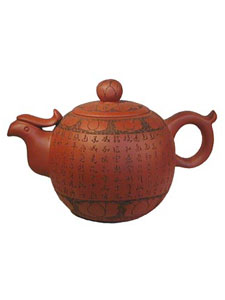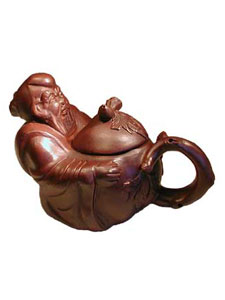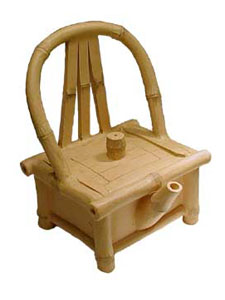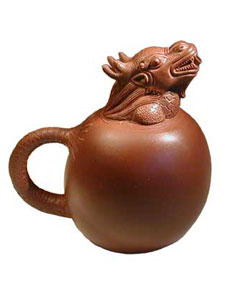Chinese Teaware: The Artistry of Yixing




Even at its simplest, the teapot is a thoroughly appealing vessel, blending seamlessly the function of brewing with the elegance of exceptional design. The "original" teapot is from China and the best were and are made from the red clay of the area around Yixing (also known as I-Hsing).
The clay, which the Chinese call zisha or purple clay, is highly fired yet totally unglazed to retain its natural porous qualities. The pots absorb the flavor and the aroma of tea so intensely that the Chinese dedicate one pot to just one type of tea, an oolong, or a Keemun, or even a grassy green Dragonwell. Mixing teas will not only taint the clay but may make any subsequent tea taste "off." The legend is that, after twenty years, one needn't even put leaves into the pot, just water, which will then be flavored with the essence of decades of tea drinking.
The ores in the purple clay often are scooped out and used to develop black, pale beige, or a blue-green color; and many are enhanced for additional hue and nuance. From the tiny to the modest four-cup, Yixing pots are as sought after today as they were centuries ago.
Just as the Chinese esteemed nature in other arts, the teapot reflected favorite elements of nature: lotus, tree branches, leaves and others. Geometrical shapes, sensuous curved ones, and nearly round ones almost resembling pumpkins became popular shapes and all of them can be seen in today's designs which have been greatly extended to cover the most eccentric of designs including animals, flowers, bamboo, and more.
So important and valued were these pots in their days of origin, during the Sung Dynasty (960-1279). that noblemen and aristocrats throughout China spent fortunes to amass collections of the finest pots made by the most esteemed artists and craftsmen. Even today, the best potters are referred to as "national treasures" for their timeless artistry. Artisans' pots are worth hundreds of thousands of dollars, yet even the most modestly machine made pot of twenty dollars or less, can provide years of pleasurable tea drinking.
Perhaps the most famous Sung-era story, one shared by writer John Blofeld in "The Chinese Art of Tea," is about a nobleman who lived in the area of Hu-Chou. The man had amassed a collection of teapots known to be the most beautiful and ethereal. He acquired teapots everywhere and anywhere he traveled, using them lovingly to drink his daily tea. With the same ardor, he sought the finest tea farmers and purchased only the freshest most perfectly processed teas.
One day, a man who obviously looked like a beggar, wearing tattered clothing, and the disheveled look of someone unused to the finer things in life, called upon the nobleman at his home. After some hesitancy by the servant opening the door, the beggar was allowed to meet the nobleman and make his request in person.
In a surprisingly cultivated and mellifluous voice, the beggar said, "I have heard that the tea you drink is the finest in the land. Perhaps you will indulge me in sharing a cup of your superb tea."
The nobleman was astonished at the request, believing that the looks of the beggar covered a man naÔve to the delicacies of fine tea. Nonetheless, he ordered tea to be prepared in one of his finest pots, and the beggar inhaled the aroma, took several thoughtful sips, then leaned back in the chair with a look of disappointment upon his face.
"Ah," he said, "the aroma is too faint, the flavor too mild. It is quite possible, sir, that your teapot, as beautiful as it is, simply is too new to brew the tea to its perfection. A teapot of several decades of use is required here."
Unwilling to believe that this beggar was the connoisseur he professed to be, the nobleman challenged him.
"Yes," the reply came, "it is easy to believe I am a beggar, but actually I am a formerly rich man in beggars clothing. My passion for tea overcame everything in my life. Eventually I sold my possessions, all but my most beloved teapot," he said, pulling out a small Yixing teapot from the folds of his ragged clothing. "Would you like to sample your tea in my precious pot? Its rich clay has absorbed the pleasures of the leaf for decades now."
And, so the nobleman scooped some of his cherished tea leaves into the old beloved pot, brewed it with hot water, timed its brew, and the two gentlemen sipped from its nectar. "Yes," the nobleman said after a long silence, "I understand now. I must have this pot for my collection! I will offer you fifty pieces of gold for it."
"Sorry," was the reply, "I would not be able to part with this pot for ten thousand pieces of gold."
The two men continued to sip their tea in silence, until the beggar broke the calm with his proposal. "I see that you understand the pleasures of tea and the importance of a well-loved pot. I am willing to share this pot with you for but five hundred pieces of silver. Should you agree, I will even leave this pot here, on one condition, and once a day I may come by to enjoy its beauty and the delectable tea with you."
And so it came to be that the two men, day after day, met to drink tea together, each enjoying the finely weathered pot that provided the fullest flavor to the finest tea.
The next time you reach for your most beloved pot, stained and worn from years of loving use, remember that it is just now coming into its prime!
If you would like to use an Yixing pot, follow the seller's directions for seasoning the pot. Put a heaping teaspoon of the tea you would like to dedicate the pot to, and cover with hot water. Allow to steep and pour out the liquor. Re-brew and pour out the liquor. Discard the leaves, then pour in hot water only and swish it around, then pour that liquid out. Your pot is now "seasoned" for your favorite tea. After each use, discard all the leaves, rinse out thoroughly with hot water, and air dry with the lid off. Replace on your shelf until your next tea experience. Your teapot should last several generations!
To view a large collection (over 100 different styles) of authentic Yixing teapots, some of which appear as illustrations above, please visit http://www.yixing.com
